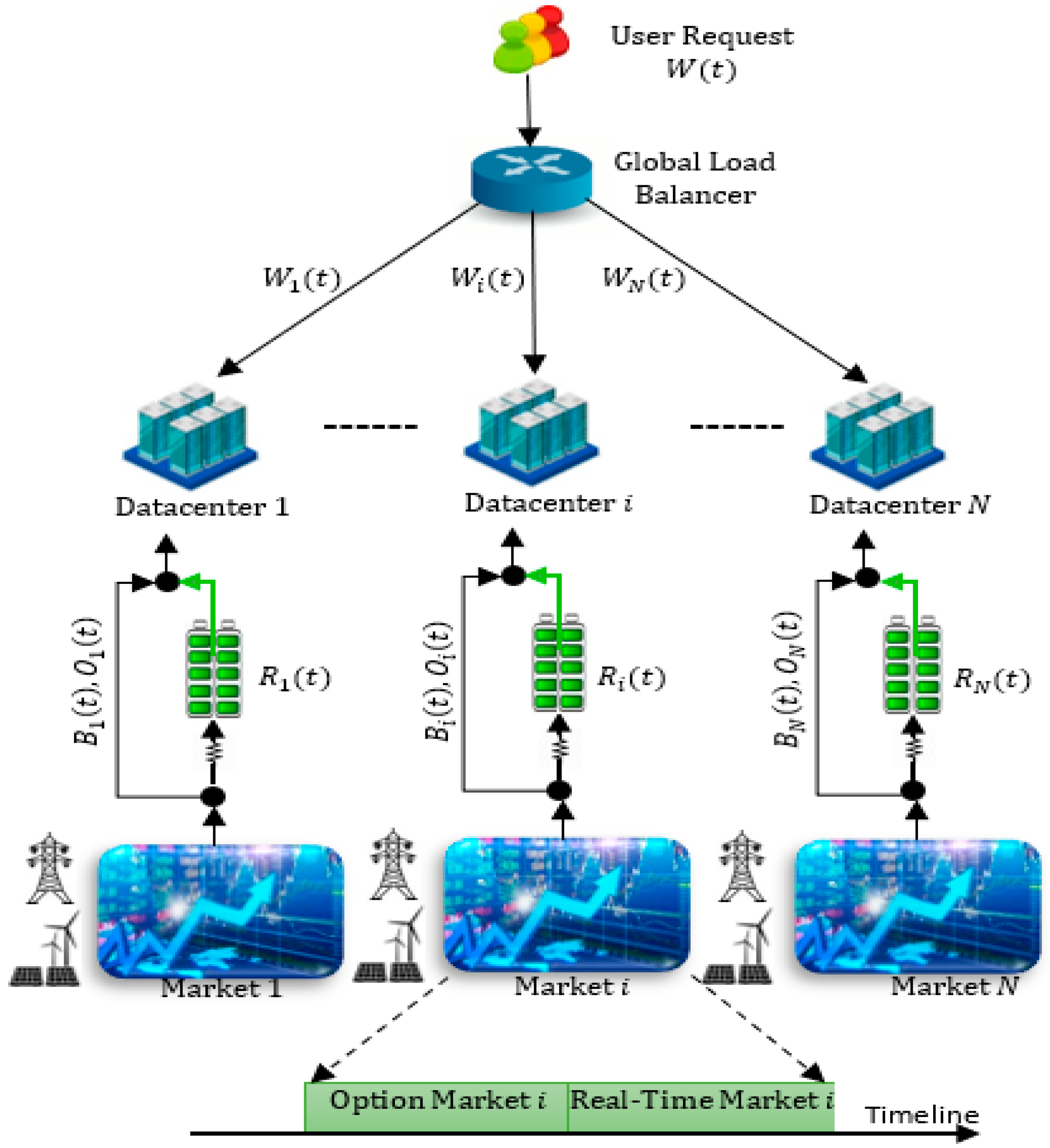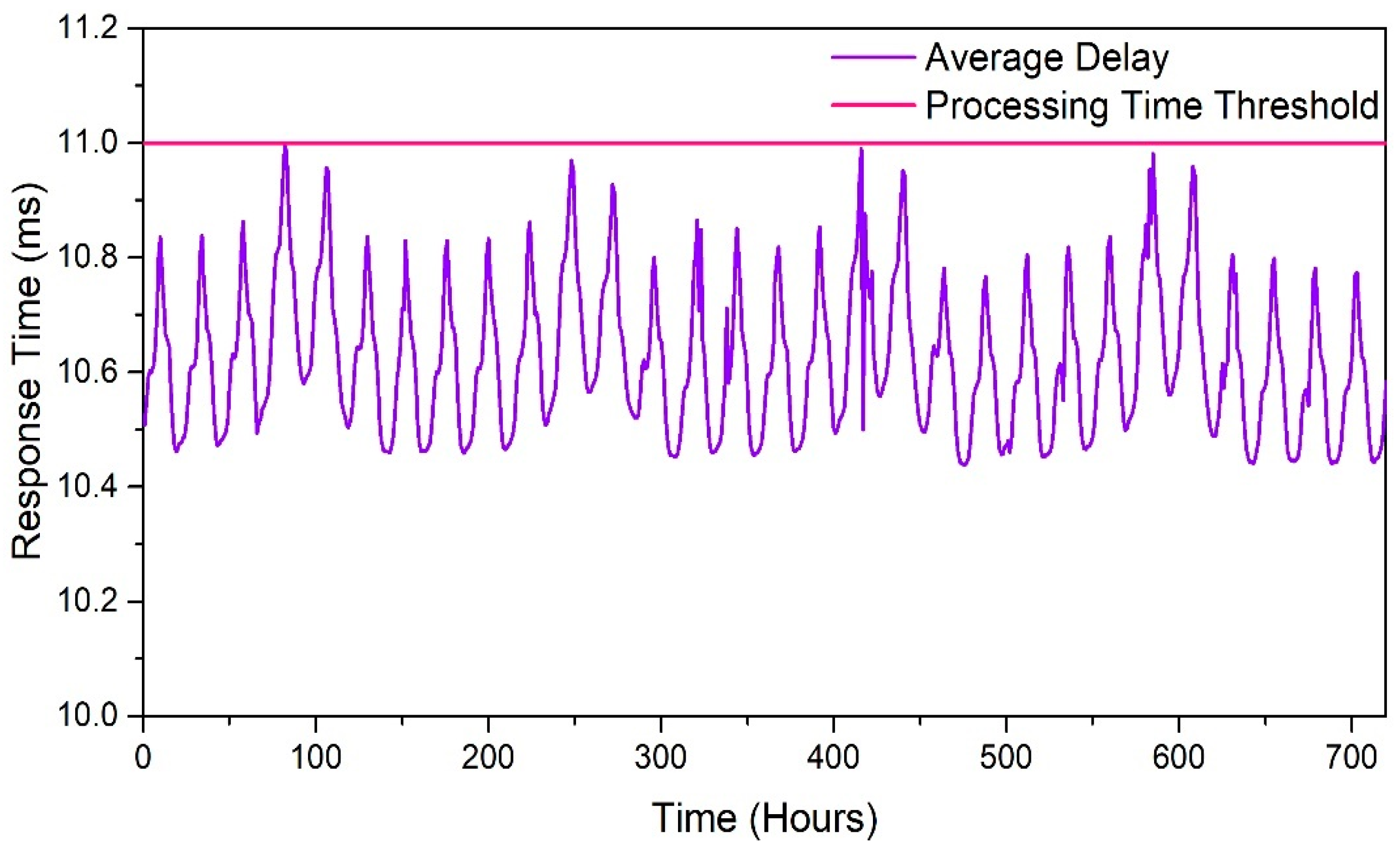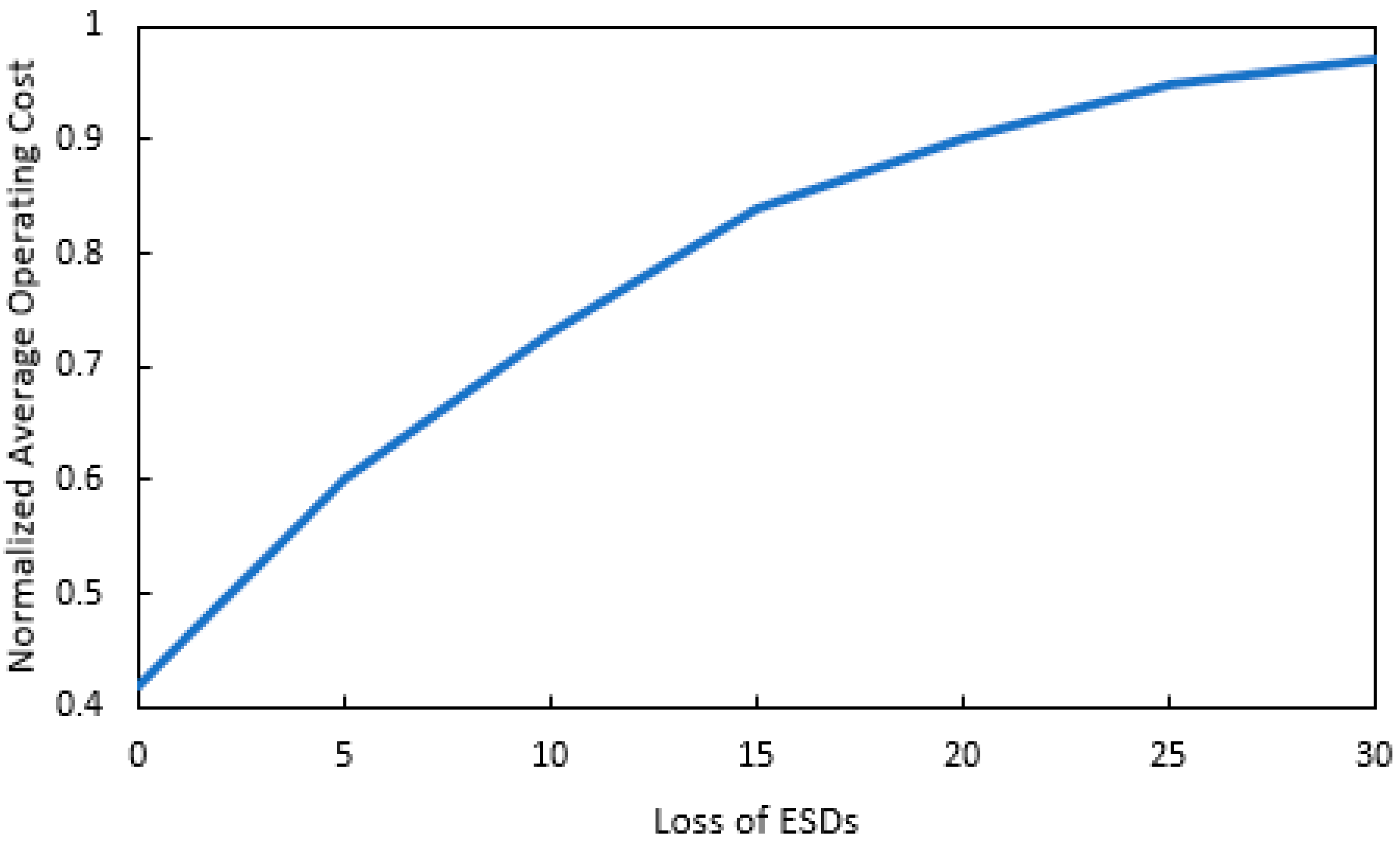Renewable-Aware Geographical Load Balancing Using Option Pricing for Energy Cost Minimization in Data Centers
Abstract
1. Introduction
2. Related Work
2.1. GLB and Power Management
2.2. GLB and Geo-Distributed Data Centers
2.3. Renewable Energy and Storage
3. Problem Setting
3.1. Problem Formulation
3.2. The Model of Incoming Workload
3.3. The Model of Quality of Service (Delay)
3.4. The Model of Power Utilization
3.5. The Model of Renewable Energy
4. GLB Optimization Problem
4.1. Problem-I: Calculate the Value of Electricity Call Option (V)
4.2. Problem-II: Minimization of Energy Cost
5. Proposed Solution
5.1. Problem-I: Calculate V
| Algorithm 1: RLB-Option |
| Part A: Determine the value of |
| . |
| . |
| 4: Subject to constraints (7) and (8) |
| then purchase the call option for electricity end if |
| Part B: Energy Cost Minimization—Solve the Optimization Problem |
|
| 9: if |
| 10: |
| 11: end if |
|
| 12: if then |
| 13: & |
| 14: |
| 15: |
| 16: |
| 17: end if |
|
| 18: & |
|
| 19: for do |
| 20: if OR then |
| 21: |
| 22: |
| 23: else if then |
| 24: |
| 25: end if |
| 26: |
| 27: |
| 28: end for |
5.2. Problem-II: Energy Cost Minimization—Solve the Optimization Problem
6. Numerical Evaluation
6.1. Experimental Setup
6.1.1. Description of Geo-Distributed Data Centers
6.1.2. Description of Incoming Workload
- URL;
- Start and finish time of every user request;
- A flag that indicates whether the workload information in a database has been updated or not;
- A counter used to sort the user requests.
6.1.3. Description of Energy Prices
6.1.4. Baseline Algorithms
- i.
- Baseline Algorithm-I (BA1) [17]: In this approach, the authors considered energy storage devices powered by brown energy, option pricing, and dynamic energy prices to process the incoming user request. Brown energy from the grid is the primary energy source in BA1. However, neither thermal storage nor renewable energy are considered in this workload allocation strategy.
- ii.
- Baseline Algorithm-II (BA2) [2]: This strategy ignores option pricing in favour of deploying energy storage devices and the least expensive time-varying power costs to fulfil incoming user demands. In BA2, workloads are sent to the closest geo-distributed data center for immediate processing. Many businesses already use this strategy, prioritizing meeting incoming workloads as quickly as possible over saving money on energy costs or using renewable resources.
- iii.
- Baseline Algorithm-III (BA3) [1]: In this method, GLB is used exclusively to prioritize incoming user requests, with consideration given only to the time-varying call option. The strategy does not account for energy storage or fluctuating electricity costs in the real-time market, instead relying solely on options from the derivatives market to power data centers.
6.2. Numerical Results
6.2.1. Energy Cost Minimization Using Renewable Aware Load Balancing
6.2.2. Minimizing Average Delay Cost
6.2.3. Trade-Off between Delay and Cost
6.2.4. Impact of ESD Cost
7. Concluding Remarks and Future Work
Author Contributions
Funding
Data Availability Statement
Acknowledgments
Conflicts of Interest
References
- Ahmad, I.; Khalil, M.I.K.; Shah, S.A.A. Optimization-based workload distribution in geographically distributed data centers: A survey. IEEE Trans. Parallel Distrib. Syst. 2020, 33, e4453. [Google Scholar] [CrossRef]
- Chen, T.; Marques, A.G.; Giannakis, G.B. DGLB: Distributed stochastic geographical load balancing over cloud networks. IEEE Trans. Parallel Distrib. Syst. 2016, 28, 1866–1880. [Google Scholar] [CrossRef]
- Alboaneen, D.; Tianfield, H.; Zhang, Y.; Pranggono, B. A metaheuristic method for joint task scheduling and virtual machine placement in cloud data centers. Future Gener. Comput. Syst. 2021, 115, 201–212. [Google Scholar] [CrossRef]
- Bibri, S.E. The IoT for smart sustainable cities of the future: An analytical framework for sensor-based big data applications for environmental sustainability. Sustain. Cities Soc. 2018, 38, 230–253. [Google Scholar] [CrossRef]
- Black, F.; Scholes, M. The pricing of options and corporate liabilities. World Sci. Ref. Conting. Claims Anal. Corp. Financ. 2019, 1, 3–21. [Google Scholar]
- Burger, M.; Klar, B.; Muller, A.; Schindlmayr, G. A spot market model for pricing derivatives in electricity markets. Quant. Financ. 2003, 4, 109. [Google Scholar] [CrossRef]
- Camacho, J.; Zhang, Y.; Chen, M.; Chiu, D.M. Balance your bids before your bits: The economics of geographic load-balancing. In Proceedings of the 5th International Conference on Future Energy Systems, Cambridge, UK, 11–13 June 2014; pp. 75–85. [Google Scholar]
- Chau, C.K.; Yang, K. Competitive online algorithms for geographical load balancing in data centers with energy storage. In Proceedings of the 5th International Workshop on Energy Efficient Data Centers, Waterloo, ON, Canada, 21–24 June 2016; pp. 1–6. [Google Scholar]
- Conejo, A.J.; Carcia-Bertrand, R.; Carrion, M.; Caballero, A.; De-Andres, A. Optimal involvement in futures markets of a power producer. IEEE Trans. Power Syst. 2008, 23, 703–711. [Google Scholar] [CrossRef]
- Xu, X.; Niu, D.; Xiao, B.; Guo, X.; Zhang, L.; Wang, K. Policy analysis for grid parity of wind power generation in China. Energy Policy 2020, 138, 111225. [Google Scholar] [CrossRef]
- Li, H.; Hou, K.; Xu, X.; Jia, H.; Zhu, L.; Mu, Y. Probabilistic energy flow calculation for regional integrated energy system considering cross-system failures. Appl. Energy 2022, 308, 118326. [Google Scholar] [CrossRef]
- Wang, H.; Hou, K.; Zhao, J.; Yu, X.; Jia, H.; Mu, Y. Planning-Oriented resilience assessment and enhancement of integrated electricity-gas system considering multi-type natural disasters. Appl. Energy 2022, 315, 118824. [Google Scholar] [CrossRef]
- Din, S.; Ahmad, A.; Paul, A.; Rathore, M.M.U.; Jeon, G. A cluster-based data fusion technique to analyze big data in wireless multi-sensor system. IEEE Access 2017, 5, 5069–5083. [Google Scholar] [CrossRef]
- Dou, H.; Qi, Y.; Wei, W.; Song, H. Minimizing electricity bills for geographically distributed data centers with renewable and cooling aware load balancing. In Proceedings of the International Conference on Identification, Information, and Knowledge in the internet of Things (IIKI), Beijing, China, 22–23 October 2015; pp. 210–214. [Google Scholar]
- Guo, C.; Luo, F.; Cai, Z.; Dong, Y.; Zhang, R. Integrated planning of internet data centers and battery energy storage systems in smart grids. Appl. Energy 2021, 281, 116093. [Google Scholar] [CrossRef]
- Helali, L.; Qomri, M.N. A survey of data center consolidation in cloud computing systems. Comput. Sci. Rev. 2020, 39, 100366. [Google Scholar] [CrossRef]
- Khalil, M.I.K.; Ahmad, I.; Shah, S.A.A.; Jan, S.; Khan, F.Q. Energy cost minimization for sustainable cloud computing using option pricing. Sustain. Cities Soc. 2020, 63, 102440. [Google Scholar] [CrossRef]
- Xiao, Y.; Zuo, X.; Huang, J.; Konak, A.; Xu, Y. The continuous pollution routing problem. Appl. Math. Compute. 2020, 387, 125072. [Google Scholar] [CrossRef]
- Zhang, L.; Liu, D.; Cai, G.; Lyu, L.; Koh, L.H.; Wang, T. An optimal dispatch model for virtual power plant that incorporates carbon trading and green certificate trading. Int. J. Electr. Power Energy Syst. 2023, 144, 108558. [Google Scholar] [CrossRef]
- Yang, J.; Liu, H.; Ma, K.; Yang, B.; Guerrero, J.M. An Optimization Strategy of Price and Conversion Factor Considering the Coupling of Electricity and Gas Based on Three-Stage Game. IEEE Trans. Autom. Sci. Eng. 2022, 1–14. [Google Scholar] [CrossRef]
- Ma, K.; Hu, X.; Yue, Z.; Wang, Y.; Yang, J.; Zhao, H.; Liu, Z. Voltage Regulation with Electric Taxi Based on Dynamic Game Strategy. IEEE Trans. Veh. Technol. 2022, 71, 2413–2426. [Google Scholar] [CrossRef]
- Ma, K.; Li, Z.; Liu, P.; Yang, J.; Geng, Y.; Yang, B.; Guan, X. Reliability-Constrained Throughput Optimization of Industrial Wireless Sensor Networks with Energy Harvesting Relay. IEEE Internet Things J. 2021, 8, 13343–13354. [Google Scholar] [CrossRef]
- Ghamkhari, M.; Mohenian-Rad, H.; Wierman, A. Optimal risk-aware power procurement for data centers in day-ahead and real-time electricity markets. In Proceedings of the 2014 IEEE Conference on Computer Communications Workshops (INFOCOM WKSHPS), Toronto, ON, Canada, 27 April–2 May 2014; pp. 610–615. [Google Scholar]
- Gong, X.; Wang, L.; Mou, Y.; Wang, H.; Wei, X.; Zheng, W.; Yin, L. Improved Four-channel PBTDPA Control Strategy Using Force Feedback Bilateral Teleoperation System. Int. J. Control 2022, 20, 1002–1017. [Google Scholar] [CrossRef]
- Wang, J.; Tian, J.; Zhang, X.; Yang, B.; Liu, S.; Yin, L.; Zheng, W. Control of Time Delay Force Feedback Teleoperation System with Finite Time Convergence. Front. Neurorobot. 2022, 16, 877069. [Google Scholar] [CrossRef] [PubMed]
- Du, Y.; Qin, B.; Zhao, C.; Zhu, Y.; Cao, J.; Ji, Y. A Novel Spatio-Temporal Synchronization Method of Roadside Asynchronous MMW Radar-Camera for Sensor Fusion. IEEE Trans. Intell. Transp. Syst. 2021, 1–12. [Google Scholar] [CrossRef]
- Li, Y.; Che, P.; Liu, C.; Wu, D.; Du, Y. Cross-scene pavement distress detection by a novel transfer learning framework. Comput.-Aided Civ. Infrastruct. Eng. 2021, 36, 1398–1415. [Google Scholar] [CrossRef]
- Guo, Y.; Fang, Y. Electricity cost saving strategy in data centers by using energy storage. IEEE Trans. Parallel Distrib. Syst. 2012, 24, 1149–1160. [Google Scholar] [CrossRef]
- Guo, Y.; Gong, Y.; Khargonekar, P.P.; Geng, X. Energy and network aware workload management for sustainable data centers with thermal storage. IEEE Trans. Parallel Distrib. Syst. 2013, 25, 2030–2042. [Google Scholar] [CrossRef]
- Bilal, J.; Farman, H.; Khan, M.; Imran, M.; Islam, I.U.; Ahmad, A.; Ali, S.; Jeon, G. Deep learning in big data analytics: A comparative study. Comput. Electr. Eng. 2019, 75, 275–287. [Google Scholar]
- Khalil, M.I.K.; Ahmad, I.; Almazroi, A.A. Energy efficient indivisible workload distribution in geographically distributed data centers. IEEE Access 2019, 7, 82672–82680. [Google Scholar] [CrossRef]
- Lin., M.; Liu, Z.; Wierman, A.; Andrew, L.L.M. Online algorithms for geographical load balancing. In Proceedings of the 2012 International Green Computing Conference (IGCC), San Jose, CA, USA, 4–8 June 2012; pp. 1–10. [Google Scholar]
- Qureshi, A.; Weber, R.; Balakrishnan, H.; Guttag, J.; Maggs, B. Cutting the electric bill for internet-scale systems. In Proceedings of the ACM SIGCOMM Conference on Data Communication, Barcelona, Spain, 16–21 August 2009; pp. 123–134. [Google Scholar]
- Mohammed, S.S.; Ahamed, T.P.; Aleem, S.H.; Omar, A.I. Interruptible charge scheduling of plug-in electric vehicle to minimize charging cost using heuristic algorithm. Electr. Eng. 2022, 104, 1425–1440. [Google Scholar] [CrossRef]
- Lin, L.; Chen, C.; Wei, B.; Li, H.; Shi, J.; Zhang, J.; Huang, N. Residential Electricity Load Scenario Prediction Based on Transferable Flow Generation Model. J. Electr. Eng. Technol. 2022, 1–11. [Google Scholar] [CrossRef]
- Luo, G.; Yuan, Q.; Li, J.; Wang, S.; Yang, F. Artificial intelligence powered mobile networks: From cognition to decision. IEEE Netw. 2022, 36, 136–144. [Google Scholar] [CrossRef]
- Luo, G.; Zhang, H.; Yuan, Q.; Li, J.; Wang, F. ESTNet: Embedded Spatial-Temporal Network for Modeling Traffic Flow Dynamics. IEEE Trans. Intell. Transp. Syst. 2022, 1–12. [Google Scholar] [CrossRef]
- Xu, L.; Liu, X.; Tong, D.; Liu, Z.; Yin, L.; Zheng, W. Forecasting Urban Land Use Change Based on Cellular Automata and the PLUS Model. Land 2022, 11, 652. [Google Scholar] [CrossRef]
- Zhang, Y.; Shi, X.; Zhang, H.; Cao, Y.; Terzija, V. Review on deep learning applications in frequency analysis and control of modern power system. Int. J. Electr. Power Energy Syst. 2022, 136, 107744. [Google Scholar] [CrossRef]
- Xu, X.; Niu, D.; Peng, L.; Zheng, S.; Qiu, J. Hierarchical multi-objective optimal planning model of active distribution network considering distributed generation and demand-side response. Sustain. Energy Technol. Assess. 2022, 53, 102438. [Google Scholar] [CrossRef]
- Xie, X.; Sun, Y. A piecewise probabilistic harmonic power flow approach in unbalanced residential distribution systems. Int. J. Electr. Power Energy Syst. 2022, 141, 108114. [Google Scholar] [CrossRef]
- Rao, L.; Liu, X.; Xie, L.; Liu, W. Minimizing electricity cost: Optimization of distributed internet data centers in a multi-electricity-market environment. In Proceedings of the IEEE INFOCOM, San Diego, CA, USA, 14–19 March 2010; pp. 1–9. [Google Scholar]
- Paul, D.; Zhong, W.D. Price and renewable aware geographical load balancing technique for data centres. In Proceedings of the International Conference on Information, Communications & Signal Processing, Tainan, Taiwan, 10–13 December 2013; pp. 1–5. [Google Scholar]
- Pineda, S.; Conejo, A.J. Using electricity options to hedge against financial risks of power producers. J. Mod. Power Syst. Clean Energy 2013, 1, 101–109. [Google Scholar] [CrossRef]
- Liu, Z.; Lin, M.; Wierman, A.; Low, S.H.; Andrew, L.L.H. Geographical load balancing with renewables. ACM Sigmetrics Perform. Eval. Rev. 2011, 39, 62–66. [Google Scholar] [CrossRef]
- Guo, Y.; Ding, Z.; Fang, Y.; Wu, D. Cutting down electricity cost in internet data centers by using energy storage. In Proceedings of the 2011 IEEE Global Telecommunications Conference—GLOBECOM 2011, Houston, TX, USA, 5–9 December 2011; pp. 1–5. [Google Scholar]
- Goudarzi, H.; Pedram, M. Geographical load balancing for online service applications in distributed datacenters. In Proceedings of the IEEE Sixth International Conference on Cloud Computing, Santa Clara, CA, USA, 28 June–3 July 2013; pp. 351–358. [Google Scholar]
- Elzei, N.M.; Majid, M.A.; Hashem, I.A.T.; Yaqoob, I.; Alaba, A.; Imran, M. Managing big RDF data in clouds: Challenges, opportunities, and solutions. Sustain. Cities Soc. 2018, 39, 375–386. [Google Scholar] [CrossRef]
- Paul, D.; Zhong, W.D.; Bose, S.K. Energy efficiency aware load distribution and electricity cost volatility control for cloud service providers. J. Netw. Comput. Appl. 2016, 59, 185–197. [Google Scholar] [CrossRef]
- Liu, Z.; Wang, Y.; Feng, J. Vehicle-type strategies for manufacturer’s car sharing. Kybernetes, 2022; ahead-of-print. [Google Scholar] [CrossRef]
- Xiao, Y.; Zhang, Y.; Kaku, I.; Kang, R.; Pan, X. Electric vehicle routing problem: A systematic review and a new comprehensive model with nonlinear energy recharging and consumption. Renew. Sustain. Energy Rev. 2021, 151, 111567. [Google Scholar] [CrossRef]
- Liu, C.; Wu, D.; Li, Y.; Du, Y. Large-scale pavement roughness measurements with vehicle crowdsourced data using semi-supervised learning. Transp. Res. Part C Emerg. Technol. 2021, 125, 103048. [Google Scholar] [CrossRef]
- Wang, H.; Wu, X.; Zheng, X.; Yuan, X. Virtual Voltage Vector Based Model Predictive Control for a Nine-Phase Open-End Winding PMSM with a Common DC Bus. IEEE Trans. Ind. Electron. 2022, 69, 5386–5397. [Google Scholar] [CrossRef]
- Ahmed, E.M.; Rathinam, R.; Dayalan, S.; Fernandez, G.S.; Ali, Z.M.; Abdel Aleem, S.H.E.; Omar, A.I. A comprehensive analysis of demand response pricing strategies in a smart grid environment using particle swarm optimization and the strawberry optimization algorithm. Mathematics 2021, 9, 2338. [Google Scholar] [CrossRef]
- Siddik, M.A.B.; Shehabi, A.; Marston, L. The environmental footprint of data centers in the United States. Environ. Res. Lett. 2021, 16, 064017. [Google Scholar] [CrossRef]
- Malik, N.; Sardaraz, M.; Tahir, M.; Shah, B.; Ali, G.; Moreira, F. Energy-efficient load balancing algorithm for workflow scheduling in cloud data centers using queuing and thresholds. Appl. Sci. 2021, 11, 5849. [Google Scholar] [CrossRef]
- Dong, J.; Liu, D.; Zhang, Y.; Wang, Y.; Dou, X. A Novel LCOE Pricing Model for Renewable Energy with Power Purchase Agreement: A Case Study in China. Processes 2021, 9, 1780. [Google Scholar] [CrossRef]
- Vilar, D.B.; Affonso, C.M. Intelligent Dynamic Pricing Scheme for Demand Response in Brazil Considering the Integration of Renewable Energy Sources. Energies 2021, 14, 4839. [Google Scholar] [CrossRef]
- Yoo, Y.S.; Jeon, S.H.; Newaz, S.S.; Lee, I.W.; Choi, J.K. Energy trading among power grid and renewable energy sources: A dynamic pricing and demand scheme for profit maximization. Sensors 2021, 21, 5819. [Google Scholar] [CrossRef]
- Hossain, M.S.; Ziaul Islam, K.; Jahid, A.; Rahman, K.M.; Ahmed, S.; Alsharif, M.H. Renewable energy-aware sustainable cellular networks with load balancing and energy-sharing technique. Sustainability 2020, 12, 9340. [Google Scholar] [CrossRef]







| Notation | Description |
|---|---|
| Discrete-time index | |
| Cloud data center index | |
| The total incoming workload | |
| Total assigned workload | |
| Maximum limit of delay | |
| Average delay | |
| Queuing delay | |
| The maximum limit of renewable energy | |
| Renewable energy at a data center | |
| Electricity price | |
| Total servers at a data center | |
| Active servers | |
| Inactive servers | |
| Service rate | |
| IT equipment power usage | |
| Total power consumption at a center | |
| Active server’s power usage | |
| Inactive server’s power usage | |
| Maximum power consumption | |
| Power from brown energy | |
| Power from call option contract | |
| Energy cost | |
| Total Cost of electricity | |
| Strike price | |
| Interest rate | |
| Option contract expiry time | |
| Future price volatility | |
| Call option probability change | |
| Spot prices probability |
| Comparison Factor | RLB-Option Improvement Over | ||
|---|---|---|---|
| BA1 | BA2 | BA3 | |
| Energy Cost | 22% | 39% | 57% |
Publisher’s Note: MDPI stays neutral with regard to jurisdictional claims in published maps and institutional affiliations. |
© 2022 by the authors. Licensee MDPI, Basel, Switzerland. This article is an open access article distributed under the terms and conditions of the Creative Commons Attribution (CC BY) license (https://creativecommons.org/licenses/by/4.0/).
Share and Cite
Khalil, M.I.K.; Shah, S.A.A.; Taj, A.; Shiraz, M.; Alamri, B.; Murawwat, S.; Hafeez, G. Renewable-Aware Geographical Load Balancing Using Option Pricing for Energy Cost Minimization in Data Centers. Processes 2022, 10, 1983. https://doi.org/10.3390/pr10101983
Khalil MIK, Shah SAA, Taj A, Shiraz M, Alamri B, Murawwat S, Hafeez G. Renewable-Aware Geographical Load Balancing Using Option Pricing for Energy Cost Minimization in Data Centers. Processes. 2022; 10(10):1983. https://doi.org/10.3390/pr10101983
Chicago/Turabian StyleKhalil, Muhammad Imran Khan, Syed Adeel Ali Shah, Amer Taj, Muhammad Shiraz, Basem Alamri, Sadia Murawwat, and Ghulam Hafeez. 2022. "Renewable-Aware Geographical Load Balancing Using Option Pricing for Energy Cost Minimization in Data Centers" Processes 10, no. 10: 1983. https://doi.org/10.3390/pr10101983
APA StyleKhalil, M. I. K., Shah, S. A. A., Taj, A., Shiraz, M., Alamri, B., Murawwat, S., & Hafeez, G. (2022). Renewable-Aware Geographical Load Balancing Using Option Pricing for Energy Cost Minimization in Data Centers. Processes, 10(10), 1983. https://doi.org/10.3390/pr10101983










